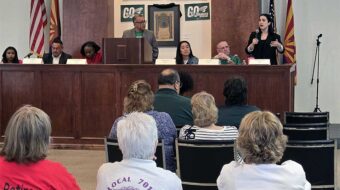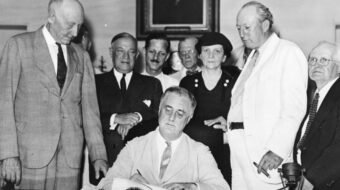
Saving Social Security from privatization will be a major theme at Labor Day celebrations around the country, as members of Congress prepare to head back to Washington. Working people are determined to put Congress on notice that any proposal that undermines or privatizes Social Security is not acceptable and must be voted down. As was done in the 1930s to win Social Security and other social legislation, a massive outpouring can achieve not only protection of Social Security, but expansion of it as well.
What is Social Security?
In 1939, President Roosevelt described Social Security as a system “providing lifetime family security instead of only individual old age security to the workers in insured occupations. In addition to the worker himself, millions of widows and orphans will now be afforded some degree of protection in the event of his death whether before or after his retirement.” Today, 62 percent of benefits are paid to retired workers, while the other 38 percent help millions of disabled workers, survivors and spouses.
Retirement and Social Security
Social Security was meant to be only a part of retirement security — company pensions and personal savings were intended to fill the gaps. But company pensions are a vanishing benefit, and personal savings can be gutted by stock market fluctuations, by the cost of children’s education, and by medical and other emergencies.
A typical family about to retire has financial assets and retirement accounts worth about $100,000 — enough for an income of only $540 per month (with no cost-of-living increases). Their monthly income from Social Security would range from $1,100 for a single person to $2,200 for two average wage earners. And Social Security payments are increased each year to keep pace with inflation. It is small wonder that Social Security is the solid foundation upon which retirement security rests. (See box, next page.) And it is small wonder that Social Security has been called the third rail of American politics — touch it, and you die!
The phony crisis
Instead of open attacks, opponents have tried to undermine confidence in the system by claiming the program faces an imminent funding crisis. These attacks gathered speed when Bush got in the White House and the Republicans captured both houses in Congress. The administration coddled the Enron/WorldCom criminals, passed huge tax cuts for the corporate elite, allowed shameless profiteering from the wars in Afghanistan and Iraq, and passed a bankruptcy bill that turns American workers into debt-slaves to their creditors. These policies give a clear signal to the big financial corporations: it is open season on the savings of the American people. And there is no bigger prize than the Social Security Trust Fund, with $553 billion in annual income and $1.7 trillion in assets.
President Bush has repeatedly claimed that Social Security will be bankrupt in 36 years. In simple language, he repeats the academic arguments developed in right-wing think tanks and spread by corporate front groups with multimillion-dollar budgets, with the help of a compliant media.
In the now-famous Downing Street Memo before the Iraq war started, a British intelligence officer warned his government that, within the Bush administration, “the intelligence and facts are being fixed around the policy” of invading Iraq. The Bush administration is using the same tactics with Social Security — “fixing” the facts to justify their policy of privatization. The Social Security crisis is no more real than the weapons of mass destruction in Iraq.
Social Security is in excellent shape now, running large surpluses. Even using conservative assumptions, Social Security can pay scheduled benefits until 2041 — far longer than it is possible to make accurate predictions about the rest of the economy.
In 2041, Social Security will not be bankrupt. At worst, with no changes in the program, it will be able to pay 70 percent of scheduled benefits — a higher benefit level than retirees get today. Using other assumptions, Social Security will be able to pay scheduled benefits indefinitely.
The shortfall, if it happens at all, can be fixed with modest changes in the program — just as was done in the 1950s, ’60s, ’70s and ’80s. Over 75 years, the Bush tax cuts will cost three times as much as any possible Social Security shortfall.
Since 1950, there has been a trend of fewer active workers for each retiree — this trend is actually slowing and will level off in 25-30 years. In the past, Social Security has been able to adjust because of the increasing productivity of workers. Future productivity increases will make it possible for living standards to rise both for active workers and retirees.
President Bush said very little about Social Security during the election campaign. As soon as the election was over, he announced that privatizing Social Security was a top priority. But after months of trying to sell privatization, up to two-thirds of those surveyed don’t trust Bush’s plan. The more people learn about privatization, the more they oppose it.
The Bush plan: ‘On your own’ society
The Bush plan does nothing to solve a possible shortfall in 2041 — it makes the problem worse by borrowing additional money now. And the Bush plan will cut benefits by up to 40 percent for retirees, survivors and disabled workers. Claims of huge returns from private accounts are contradicted even by the projections made by the Bush-appointed Social Security trustees.
But Bush is still working to enact his plan. And the stakes are huge for both sides.
On the corporate side, Wall Street and wealthy investors stand to gain billions from private accounts. And further weakening Social Security will force even more seniors into a “working retirement,” providing cheap labor for the nation’s Wal-Marts and forcing young and old workers to compete for the same jobs.
For workers, privatizing Social Security would be devastating. It is also a big step toward cutting and eliminating all government responsibility to meet people’s common needs. Bush calls it the “ownership society,” but it is a blueprint for an “on your own” society. Retirement, Medicare and public education are all in the crosshairs.
The campaign for privatization tries to “divide and conquer” by falsely blaming Social Security for problems faced by African Americans, Latinos, women and youth. For example, Bush has repeated misleading claims that African American men get a bum deal from Social Security because they are more likely to die before they can collect. His racist solution is to weaken Social Security while doing nothing about the higher death rate. Likewise, private accounts will do nothing to solve the problems faced by Latinos, women and youth, but would bring benefit cuts and insecurity to those who can least afford it. Private accounts would also increase divisions within the working class — an added bonus for corporate interests. But preserving and expanding Social Security would help to unify working people around their common interests.
The movement
Decades of efforts to oppose privatization by retiree and labor organizations laid the groundwork for a new movement to save Social Security that emerged fresh from the fightback of the 2004 elections. Unions, consumer, religious, youth and seniors’ groups, and African American and Latino organizations joined together in common cause, forming new coalitions.
A broad cross-section of the public has been mobilized against the all-out assault from the Bush administration and right-wing corporate think tanks. Thousands of town hall meetings, teach-ins, protests, petitions and postcard campaigns across the country put Congress on notice that they will be judged on this issue in the 2006 elections.
This united opposition has succeeded in delaying the Republican legislative agenda and has forced some Republican members of Congress to distance themselves from administration proposals.
The 70th birthday of Social Security was celebrated across the country. During an Aug. 13 jazz concert on the New Haven Green, thousands of people from the region were asked to send their birthday wish to Congress. A few typical replies were:
• “For it not to be privatized. Add dental, eyecare, prescriptions and 100 percent hospital coverage.” – Prospect, Conn.
• “…Keep on doing the great job. Do not change the system (no privatization). Improve the medical benefits. THANKS.” – Huntington, W.Va.
• “…That this government keeps its hands off this critical program – Happy Birthday!” – Brooklyn, N.Y.
• “…That new generations of workers who pay into the system actually be able to benefit from it later. That it NEVER be privatized!!” – New Haven, Conn.
• “…That it will survive intact long enough for my family, children and grandchildren to benefit from Social Security. Don’t dismantle the program.” – Long Island, N.Y.
• “…That George Bush leaves Social Security alone!” – Hamden, Conn.
• “…Do not touch it.” – Miami, Fla.
Danger of compromise
It would be a huge mistake to become complacent. If the movement to protect Social Security keeps up the pressure, Bush’s proposal and other privatization plans are likely to be blocked. But there is a real danger that, as a “compromise,” Congress could raise the retirement age or cut future benefits.
In class terms, all such proposals mean an increased transfer of wealth from the working class to the capitalists. Since 1983, workers have been contributing more in payroll taxes than has been paid in benefits. This surplus has been loaned to the federal government, which has spent it on tax cuts and other policies that favor the corporate class. Cutting future benefits would help keep this robbery going. But it won’t help workers.
A program for Social Security
There are three ways Social Security can and should be expanded.
Retirement age: As a result of the last Social Security “compromise,” workers must now wait until age 65 and a half to retire with full benefits. By 2009, the age will be 66, and will reach 67 in 2026. Workers who are forced to retire earlier because of health or job loss have their benefits cut. The retirement age should be returned to 65 and kept there.
Benefit levels: With one-third of retirees entirely dependent on Social Security, benefit levels are too low. Ten percent of seniors still live below the poverty level. Twenty percent are below 150 percent of poverty, as are 45 percent of senior women and 40 percent of African American and Latino women. Benefits should be increased, particularly for low-income workers.
Funding: Social Security is financed by a payroll tax, which is capped at $90,000 in wages. CEOs with multimillion-dollar salaries are only taxed on their first $90,000. And they pay no tax at all on income from stocks, bonds and rents. There is strong public support for proposals to raise the cap. But the cap should be eliminated entirely, and the Social Security tax applied to all income. This would raise $250 billion per year — more than enough to return the retirement age to 65 and increase benefits.
Joelle Fishman contributed to this article.
Social Security facts
• 33 million seniors receive Social Security retirement benefits.
• Social Security provides almost all of their income for one-third of seniors, and the majority of their income for another third.
• Social Security benefits are protected from inflation – most private pensions and annuities are not.
• Social Security is progressive, replacing a larger share of the income of low-income workers who are least likely to have other resources.
• Women are 57 percent of adult beneficiaries. Women pay 39 percent of payroll taxes, but receive 50 percent of benefits. Women benefit especially from provisions for non-working, divorced or surviving spouses.
• Social Security provides the only income for 70 percent of older African Americans, and for 80 percent of older Latino households.
• African Americans are twice as likely to receive disability benefits as white workers.
• Compared with the general population, Latinos are less likely to have employer-sponsored pension plans, but receive Social Security returns 35 percent to 60 percent higher.
• 15 million – one-third of all Social Security recipients – receive survivors’ and disability benefits.
• Men in their 20s have a 3-in-10 chance of being disabled before reaching retirement.
• About one-fifth of all men in their 20s will die before they retire. 6.8 million Americans receive survivors’ benefits, including 1.9 million children.
A brief history of Social Security
By Fred Gaboury
Think back to 1934: A nation deep in the throes of the Great Depression. Confidence in the old institutions shaken as the traditional sources of economic security: assets, labor, family and charity had all failed to one degree or another. Radical demands and proposals for action were springing like weeds from the soil of the nation’s discontent: Although differing in specifics, each demanded government action in behalf of the victims of the Great Depression.
But it was legislation introduced by Rep. Ernest Lundeen of Minnesota in January 1935 that finally propelled the issue of social security onto the congressional agenda. In its four sections, written on two sides of a letter-size sheet of paper, HR 2827 provided for “the establishment of unemployment, old age, and social insurance” that would pay a benefit of at least $10 per week.
Although it did not pass, the Lundeen Bill still stands as a model of progressive policymaking and laid the basis for the Social Security Act, which President Roosevelt signed on Aug. 14, 1935. A Senate filibuster stymied the funding necessary for its operation, making it certain that Social Security would be a major issue in the 1936 battle for the White House.
During the campaign, Alf Landon, governor of Kansas and GOP presidential candidate, charged that the system, with its identification numbers, was a step toward totalitarianism. Newspapers that supported Landon claimed that the system would require workers to wear numbered dog tags. In language that the privatizers still use, factory managers warned workers there was no guarantee they would even see their benefits unless Congress decided to make the appropriation for that purpose.
Roosevelt won with 61 percent of the popular vote, which also returned a big New Deal majority in Congress. Landon’s resounding defeat helped make Social Security the sacrosanct program it eventually became, despite a constant drumbeat from the right branding any social welfare program as the first step on the road to Communist totalitarianism.
A. Philip Randolph said it best when he said, “You get what you can take, and you keep what you can hold. If you can’t take anything, you won’t get anything. And if you can’t hold anything, you won’t keep anything.”
The creation of a coalition of left and center forces can win the battle against those who would destroy the Social Security system as we have known it. … We can have more social security in the future if we can strengthen the Social Security system of today.
Excerpts of a paper delivered to the Socialist Scholars Conference, April 14, 2002.










